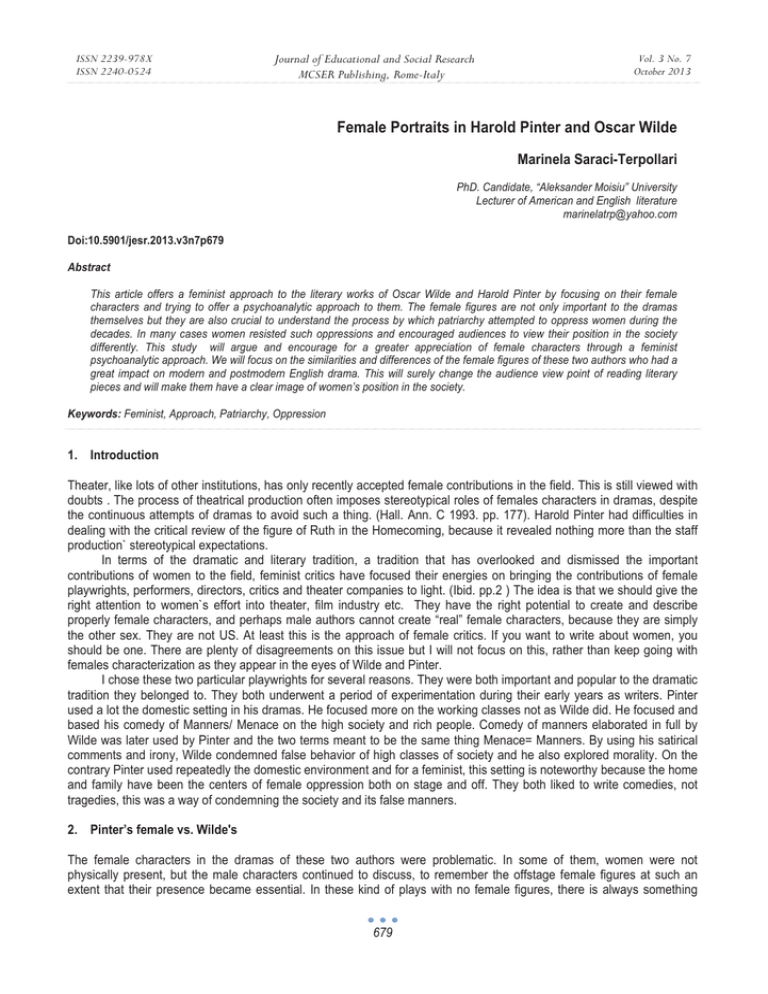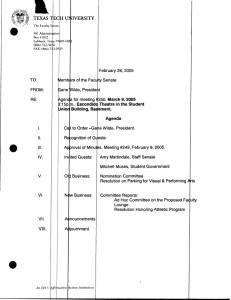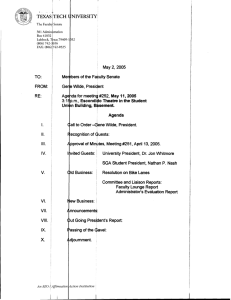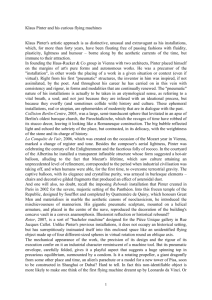Female Portraits in Harold Pinter and Oscar Wilde Marinela Saraci-Terpollari
advertisement

ISSN 2239-978X ISSN 2240-0524 Journal of Educational and Social Research MCSER Publishing, Rome-Italy Vol. 3 No. 7 October 2013 Female Portraits in Harold Pinter and Oscar Wilde Marinela Saraci-Terpollari PhD. Candidate, “Aleksander Moisiu” University Lecturer of American and English literature marinelatrp@yahoo.com Doi:10.5901/jesr.2013.v3n7p679 Abstract This article offers a feminist approach to the literary works of Oscar Wilde and Harold Pinter by focusing on their female characters and trying to offer a psychoanalytic approach to them. The female figures are not only important to the dramas themselves but they are also crucial to understand the process by which patriarchy attempted to oppress women during the decades. In many cases women resisted such oppressions and encouraged audiences to view their position in the society differently. This study will argue and encourage for a greater appreciation of female characters through a feminist psychoanalytic approach. We will focus on the similarities and differences of the female figures of these two authors who had a great impact on modern and postmodern English drama. This will surely change the audience view point of reading literary pieces and will make them have a clear image of women’s position in the society. Keywords: Feminist, Approach, Patriarchy, Oppression 1. Introduction Theater, like lots of other institutions, has only recently accepted female contributions in the field. This is still viewed with doubts . The process of theatrical production often imposes stereotypical roles of females characters in dramas, despite the continuous attempts of dramas to avoid such a thing. (Hall. Ann. C 1993. pp. 177). Harold Pinter had difficulties in dealing with the critical review of the figure of Ruth in the Homecoming, because it revealed nothing more than the staff production` stereotypical expectations. In terms of the dramatic and literary tradition, a tradition that has overlooked and dismissed the important contributions of women to the field, feminist critics have focused their energies on bringing the contributions of female playwrights, performers, directors, critics and theater companies to light. (Ibid. pp.2 ) The idea is that we should give the right attention to women`s effort into theater, film industry etc. They have the right potential to create and describe properly female characters, and perhaps male authors cannot create “real” female characters, because they are simply the other sex. They are not US. At least this is the approach of female critics. If you want to write about women, you should be one. There are plenty of disagreements on this issue but I will not focus on this, rather than keep going with females characterization as they appear in the eyes of Wilde and Pinter. I chose these two particular playwrights for several reasons. They were both important and popular to the dramatic tradition they belonged to. They both underwent a period of experimentation during their early years as writers. Pinter used a lot the domestic setting in his dramas. He focused more on the working classes not as Wilde did. He focused and based his comedy of Manners/ Menace on the high society and rich people. Comedy of manners elaborated in full by Wilde was later used by Pinter and the two terms meant to be the same thing Menace= Manners. By using his satirical comments and irony, Wilde condemned false behavior of high classes of society and he also explored morality. On the contrary Pinter used repeatedly the domestic environment and for a feminist, this setting is noteworthy because the home and family have been the centers of female oppression both on stage and off. They both liked to write comedies, not tragedies, this was a way of condemning the society and its false manners. 2. Pinter’s female vs. Wilde's The female characters in the dramas of these two authors were problematic. In some of them, women were not physically present, but the male characters continued to discuss, to remember the offstage female figures at such an extent that their presence became essential. In these kind of plays with no female figures, there is always something 679 ISSN 2239-978X ISSN 2240-0524 Journal of Educational and Social Research MCSER Publishing, Rome-Italy Vol. 3 No. 7 October 2013 missing. They are emotionally or mentally absent. They are forced to play a part against their will. Female subjectivity is not taken into account. Lacan reinforced this view in his theory. He was against the idea of Freud that women are castrated and as a result they lack power. On the other hand he thought that all human subjects “Lack”. Something is always missing according to him. (Ibid. pp.7) I think this is revolutionary about this theory. Male subjects do not have anything more than women. In fact Lacan implies that women have a better understanding of the human condition and therefore a better understanding of existence and a greater opportunity for self-knowledge. He stresses as well that definitions of gender are constructed by the patriarchy's desire to create an imaginary sense of psychic completion. In a patriarchal society women are always invisible. (Ibid. pp. 7) As Rita Felski discussed, male authors were only good at creating Madonnas or whores, the extreme categories available to women in a patriarchal society (Felski. R. 2005;51). Gender is one important axis of meaning around which men and women organize the way they read, but it is not the one that always predominates (Miller. Cristanne. pp. 375. Cited in Rita Felski. 2005). Woman of everyday life was not subject of literature themes and description. Authors preferred the extremes, but Pinter dealt with simple, ordinary, garrulous housewives. This was also due to the “Kitchen sink” realism of his dramas. He wrote them by focusing on everyday life of characters who were living on the verge of disaster. By introducing us realistic everyday life female characters, we got to know better not their motives or history, but their aims. His female characters are housewives stacked in a room and they cling forcefully to it, as it is their territory. At first they appear to be dominant wives for example Rose in The Room, or Meg at The Birthday Party. Wilde did not deal with everyday life women. Their setting was neither a single room nor a kitchen. He did not belong to the tradition of the Theatre of the Absurd which was coined later in the 1950s by Esslin. Wilde's females appear to be tender, sweet and delicate interested in wealthy and powerful men. The moral of Wilde ޗstories has nothing in common with the moral drawn in Pinter’s dramas. They donࡋ t have a moral at all in fact. Pinter disliked those authors who wanted to draw a message at the end of their works. The absurdity of human existence influenced his career a lot. This is because the 2 authors belonged to different literary periods and social contexts and the demands of the societies of those times were different. They both experimented in the first years but their philosophy of life was quite different. These influences were reflected in the description of their female figures. “An ideal husband” of Wilde, deals extensively with the role of women in the society. Gagnier argues that Wilde must be understood in relation to the audience and social institutions that “affected the construction of both” the man and his texts. (Gagnier. R. 1986. pp. 67). Women to Wilde, are a piece of art. Though the title invites speculation on the ideal husband, different figures of womanliness appear throughout the play as well. An Ideal Husband relies on a simple opposition between the virtuous Lady Chiltern and the demonic Mrs. Cheveley, the latter's wit and villainy making her a far more pleasurable character. Lady Chiltern appears as the model Victorian new woman, which Wilde elaborated while editor of the Women's World magazine in the late 1880s: morally upstanding, highly educated, and actively supportive of her husband's political career. By Act IV, she will also emerge in the role of forgiver and caretaker (again, "Pardon, not punishment, is [women's] mission"), and thus meets the more conventional demands of Victorian womanhood as well. In terms of generational differences, she stands out against the old-fashioned Lady Markby, the embodiment of an older group of society wives. Whereas Lady Chiltern is naïve, candid, and always in earnest, the witty and ambitious Mrs. Cheveley is characterized by a sort of duplicitous femininity. As described in Act I, she is a "horrid," "unnatural," and—as quickly revealed—dangerous combination of genius and beauty. Having revealed her capacity to manipulate in Act I, the play dramatically unmasks her as a monster in Act III. Trapped by Lord Goring, Cheveley dissolves into a "paroxysm of rage, with inarticulate sounds," her loss of speech giving way to an agony of terror that distorts her face. For a moment, a "mask has fallen", and Cheveley is "dreadful to look at." Her veneer of wit and beauty thus give way to the hidden beast. On the other hand, Pinter's most of the plays present the women assume the position of authority, dominance, freedom and control towards the end of the play. Harold Pinter provides the idea in his plays that no male should undermine women and the new woman is now to stay and men have to come to stipulations with this new reality of life. The characters become completely overwhelmed in their “memories” and at some point completely misplace the past and the battle for dominance in the present. (Anshu. P. 2013. pp.1 ). Deeley and Kate, and the triangle of the characters thus formed gives out an immediate representative meaning therefore the past exists in the present through memory, and past is capable of exercising conspicuous and possible impact on the present as Almansi and Henderson rightly point out: has the effect of diachronic time, since, from the outset, past and present are both manifest on the stage simultaneously, though with a different status (light versus dark; center of the room versus windows; foreground versus background). ( Almansi, G & Henderson, S. 1983. pp.86) 680 ISSN 2239-978X ISSN 2240-0524 Journal of Educational and Social Research MCSER Publishing, Rome-Italy Vol. 3 No. 7 October 2013 In Pinter’s world reality and fantasy are always in constant interplay and they are mixed. We never get to know properly whether Rose had previously been a whore or not, but this is not important. What is important is the fact that she bears the stamp of whoredom, a grave vice connected with women since a long time, like so many other Pinter heroines. Rose finds herself in a vulnerable position, Meg in the Birthday Party is ridiculed as a silly and sluttish mother; the prostitute in A Night Out feels the need for fake responsibility; Sally in the Night School has to conceal her job in the night club. The women in Pinter’s work have still to fight for their feminine integrity and their acceptance as human beings. (Sakellaridou. E.1988. pp.27) Wilde agreed on the fact that to him, women seemed to possess just what literature wanted, a light touch, a delicate hand, a graceful mode of treatment, and an unstudied felicity of phrase”. (Showalter. E. 1989. pp. 9). She stressed the fact that Salomé of Wilde is as much a site of male homosexual desire as a victim of patriarchal tyranny. Her dance is the “dance of gender”, the delicacy of the veil separating masculinity from feminine. (Ibid. pp.152). He was put as editor of a fashion magazine for women Woman ޗs World in 1887, but he molded it into an exchange of ideas about femininity , fashion, aesthetic and society. Wilde repeatedly used paradox exploiting his ability to go beyond meanings. Paradox revealed temporality of things, and as with other 20th century magazines, Woman ޗs World, was a clear paradox. It upheld feminine values, encouraged them to marry and dress elegantly, invited them to discuss war and politics, as if their opinion mattered. It advocated rational debate and the importance of education. It proved that women could be intelligent and successful, showed them freedom and adventure and finally told them that their highest duty was to stay home. (Stephanie. G. 1997. pp. 112). Even though Wilde had no experience or qualification in women's fashion or even in editing a woman’s magazine, he certainly had a high public profile and lots of well-known figures and most celebrated women, who were his friend who helped him a lot in this sense. Part of his attractiveness to women was due to the fact, while delighting in their society, they were not physically necessary to him. The real Don Juan, is not the vulgar person who goes about making love to all the women he meets, and what the novelists call “seducing” them. The real one is one who says to them , “ Go away, I do not want you. You interfere with my life I can do without you.” (Pearson, Hesketh. 1985. pp. 260.) Swift was a real Don Juan, because 2 women died for him. It is significant Martin Esslinࡋ s use of psychoanalysis: Meg with her crushing combination of motherliness and senile eroticism, is a mother image seen from the view point of an Oedipus complex…” (Pinter. H. 1978, pp. 66) The structural principle here is to see the female characters in The Birthday Party as projected facets of male protagonists. This means to see Meg a facet of Stanley or her husband. Stanley's attempts to strangle Meg and rape Lulu are then figured as: the same, immensely, complex, immensely true poetic metaphor for a basic human situation(Ibid. pp. 66) The most complicated example of patriarchal stereotyping is The Homecoming. It has generated divergent interpretations. For Esslin the play accomplishes the perfect fusion of extreme realism and wish fulfillment (Sakellaridou. E. 1988.pp. 46-7). But whose wishes are fulfilled? Ruthࡋ s acquiescence as the working mother, sexual provider and prostitute for a group of sadistic men might fulfill the wishes of this dysfunctional family. A “Woman of no Importance” of Wilde focuses on the attitudes of English high society. It deals with the problems women face in a highly prejudiced and hypocritical society of the late Victorian period. The poor opinion men have for women is clearly expressed and portrayed through the dialogue of the main character , Illinworth who says: “Beautiful women never have time. They are always so occupied in being jealous of other people's husbands”. In other words the opinion late Victorian men had for women was contemptuous and poor. It seemed as if the world went just round male characters, and women had to agree on this. This preconception prevailed the society of that time and Wilde was trying to condemn such behavior and prejudices in the late Victorian society. 3. Conclusion We can say that the influence these two great playwrights had on the British Theatre and the modern and postmodern world of literature , is remarkable. The effort they have made to represent the prejudices of the society against female figures, is impressive. We can sense the oppression of females in the respective patriarchal societies, from the style they have used in their dramas and the way they have approached so delicately to such a thorny issue. Female figures of Rose, Ruth, Meg, Kate, Lady Chiltern, Lady Windermere etc. will last forever in our minds and they will always encourage us to keep struggling for our rights and encourage as well a greater appreciation of female characters through this feminist psychoanalytic approach. 681 ISSN 2239-978X ISSN 2240-0524 Journal of Educational and Social Research MCSER Publishing, Rome-Italy Vol. 3 No. 7 October 2013 References Almansi, G.c& Henderson. S. (1983) Harold Pinter: contemporary Writers Series. London: Methuen. pp. 86 Anshu. P. (2013) Harold Pinterࡋ s Old Times, Criterion, International Journal in English. Felski. R. (2005) “Literature after Feminism”. Chicago University Press. Gagnier. R. (1986) Idylls of the marketplace: Oscar Wilde and the Victorian Public. Stanford University Press Miller. C. Literary Study's Debts to Feminism pp. 375. The Review of Rita Felski. (2005) Literature after Feminism, Chicago University Press Pinter. H. (1978) “ The Homecoming”. Plays Three. London. Methuen, pp. 66 Hall. Ann. C: (1993) “A kind of Alaska” : Women in the plays of O’Neill, Pinter and Shepard”. Southern Illinois University, USA. Pearson, H.3rd ed. (1985). The life of Oscar Wilde. Penguin books Ltd, Harmondsworth, Middlesex, England. pp. 260 Sakellaridou. E. 1988. Pinter’s female characters: A study of female characters in the plays of Harold Pinter. Barnes & Noble books, Showalter. E. (ed) Speaking of Gender. New York Routledge. 1989. Stephanie. G. (1997) “Oscar Wilde, the Woman`s World” Victorian periodicals review, Vol.30, N 2. Showalter. E. (1991) Sexual Anarchy: Gender and Culture at The Fin de Siècle. Bloomsbury. pp.152 682




